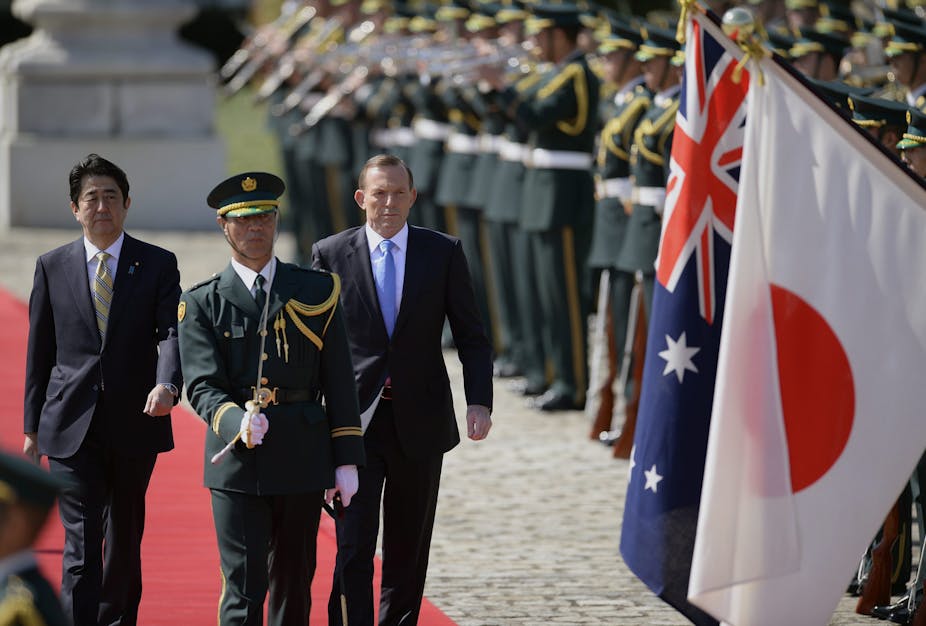In his second stint as Japan’s prime minister, Shinzo Abe seems in a hurry. His sudden fall from power in 2007 has left him with a strong sense of the need to get things done quickly. He has embarked on an ambitious reform program that appears to have finally roused the economy out of a 20-year slumber.
Abe is travelling widely around the world to sell Japan’s revitalisation and re-energise Japanese foreign policy, which had succumbed to the soporific effects of its inert economy. This week brings him to Australia, for the first prime ministerial visit from Japan since 2002.
Abe will address a joint sitting of the Houses of Parliament exactly one week after his cabinet approved a controversial new interpretation of Japan’s post-war constitution. The move will allow Japan’s Self-Defence Force to participate in combat beyond its borders for the first time since World War Two, albeit still under strict conditions.
The visit was flagged during Australian prime minister Tony Abbott’s trip to Tokyo in April and is part of an effort to cement a very close strategic relationship with Japan. This is perhaps the most important aspect of the Australian government’s foreign policy. Although trade and education links are significant aspects of the visit (Japan is Australia’s number two trading partner and a huge source of inward investment), the focus will be on the relationship’s strategic dimensions.
An old relationship moves to a new level
Australia and Japan have a long history of good bilateral relations dating back to the signing of the 1957 commerce treaty. But the current efforts build on more recent defence and security collaboration, which began in the US-led conflict in Iraq and in response to the 2004 Boxing Day tsunami. These efforts, driven by a broad-ranging sense of a changing regional security setting, led to the 2007 Japan-Australia security declaration.
Bilateral links have since flourished. Joint meetings of foreign and defence ministers began in 2007, with further agreements being signed to facilitate defence cooperation and intelligence sharing. The Rudd-Gillard governments were accused somewhat unfairly of neglecting Japan, but even their regular visits pale in comparison to the enthusiasm with which the Abbott government has embraced Abe’s Japan.

From its first days in office, the Abbott government signalled its intent, most notably when the prime minister described Japan as Australia’s “closest friend in Asia” at the UN General Assembly in September 2013. Australia also chose to back Japan’s response to China’s establishment of the Air Defence Identification Zone in the East China Sea, prompting a public dressing down of foreign minister Julie Bishop by Beijing. This year the government opted to sign an economically sub-optimal trade agreement to cement the relationship.
The Australian government is not merely strengthening an already good relationship. It is making a very public strategic commitment to a Japan that is in a period of significant transformation.
At the heart of this is the effort by the Japanese government to become a more active player in regional defence and security affairs. This openly irritates China, Australia’s premier trading partner, as well as others in the region, such as South Korea, which has difficult relations with its former colonial master.
What is Canberra’s strategy?
Australia must be mindful of the sensitivities of the rivalries in Asia when it links more closely to Japan. The determination to develop the Japan relationship is driven, however, not just by short-term aims like accessing submarine drive technology and improving trade flows but also by two broader strategic concerns.
First, Australia wants the basic international arrangements established over the past 40 years to remain in place. The US has been Asia’s preponderant military power and set the basic international rules of the game. China’s rise potentially destabilises these arrangements. The best way of ensuring the long-term persistence of the current order is for Japan to play a much greater regional role than it currently does.
Second, Australia is acutely aware of the political difficulties that this greater role may cause many in the region. It sees itself as providing crucial international support to take the worst of the diplomatic sting out of a Japan that is doing more with its military in Asia. If Japan is in partnership with the US, Australia and others, so the logic goes, it signals clearly that it is not a return to 1935.
Managing risks in hope of reward
The development of an extremely close, almost alliance-like relationship with a liberal democracy is not without its risks. China, for one, feels that Australia seems to be working with the US and others to contain its potential.
Beijing is mistaken. But Washington, and its allies are, whether wittingly or not, essentially telling Beijing that China has to accept the international arrangements that currently exist; there’s no scope to negotiate the nature of the deal on offer.
It is in establishing such a black-and-white understanding of the emerging regional order that Australia’s relationship with Japan is most fraught with risk. If it works, if China accepts the deal, Asia’s prospects are extremely good. If it does not, and China’s actions in the past few years indicate that it is not likely to, then the region is going to be a much more dangerous and contested place.
Prime ministers Abe and Abbott have much to talk about this week.
Further reading: Abe’s Australia visit comes in the wake of constitutional controversy

